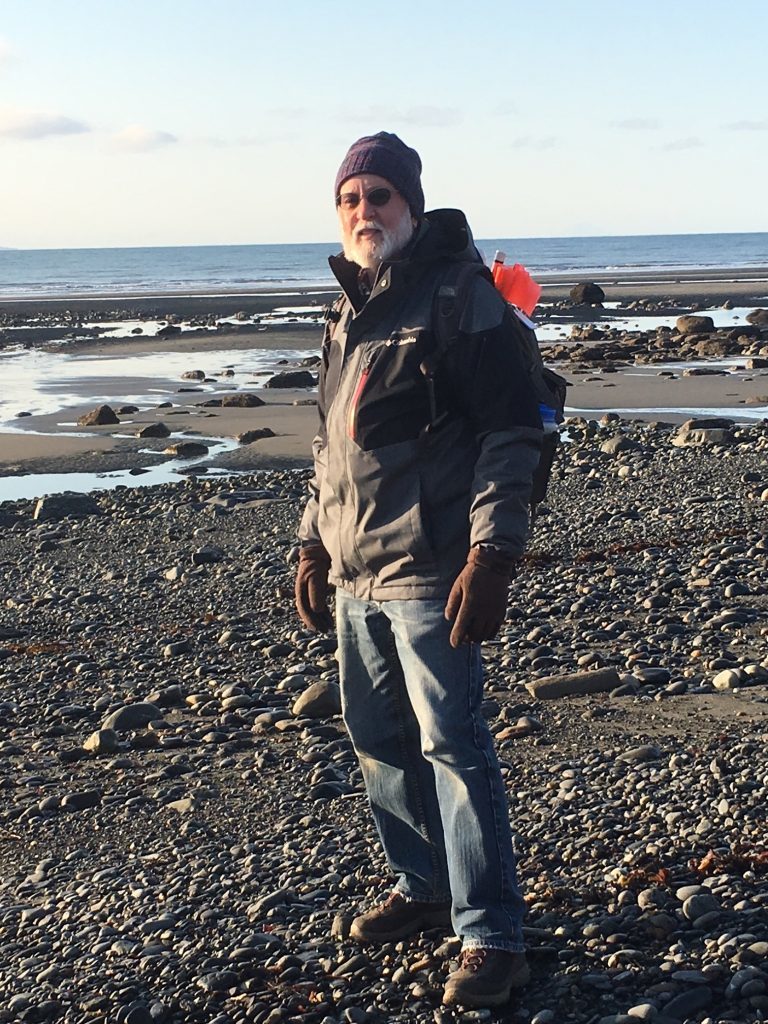by Eric Wagner
Most COASSTers, once they have been at it for a while, get to know their beach pretty well. They become attuned to the subtle shifts and changes of its features—the eroding bluffs, say, or beach grass as it creeps across the dunes. These features are proxies for time: not only a way to witness the natural world’s inherent dynamism, but also a visual measure of a volunteer’s commitment to a place.
For Paul Allan, the feature that best marks his time on Bishop’s Beach West is a rusted van someone pushed off the bluff. “It was just lying there, so we had to report it as a large piece of marine debris,” he says. That was four years ago. Since then, he has watched the van slowly disintegrate, watched the waves and tide push it around and partially bury it. “It’s like Mother Nature is bringing it back into the fold, little by little,” he says.
Paul and his wife, Louise Ashmun, started volunteering with COASST in 2014, when they moved to Homer, Alaska. For them, it was a return to the last frontier; they had lived in Alaska for twenty-odd years before heading south to Seattle, Washington, so Louise could train as an engineer. After graduation, she got a job with the U.S. Forest Service in Moscow, Idaho, while Paul continued working in science education. As a classroom teacher, he mostly taught physics, but also oceanography, chemistry, and math through calculus. He ended his career at the University of Idaho, where he was the program manager for the university’s GK-12 program, an initiative run by the National Science Foundation that helps graduate students hone their communication and teaching skills. Then one of Allan’s daughters started working as an environmental toxicologist for NOAA in Anchorage, so in 2013 Paul and Louise flew up to visit.
“My wife said, ‘We just have to move back here,’” Paul says. Which was how they ended up retiring in Homer. Once there they looked for ways to get involved with the community, and joined the Kachemak Bay birding group. “COASST was a natural extension from that,” Paul says. “A lot of people were already involved, so we jumped right in.”
They were given their stretch of Bishop’s Beach. The beach proper starts where Homer ends, along the shores of Kachemak Bay on the Kenai Peninsula. Its main part is a popular hangout for town residents, but head farther west and you come to a more isolated section called The Bluffs. Here you will see huge sandy cliffs, some of which tower more than one hundred feet above the beach. (You can also see what’s left of the aforementioned van.) “We really enjoy sort of being forced to go on this section of the beach,” Paul says. “It’s not a place we would necessarily walk regularly.”
Bishop’s Beach West is not the most active beach on the COASST roster; Paul and Louise usually find a measurable carcass three or four times a year, and while one of them was “really gross and maggoty and clenched our stomachs,” most are clean. Not that they mind either way. “Both of us having done so much science, we were used to dissecting frogs and worms,” Paul says. “The dead body thing doesn’t bother us too much.”
That said, during the most recent die-off of Common Murres, Paul and Louise were finding ten to twenty-five carcasses on each visit. “We followed the protocol and went out twice a month a couple of times,” Paul says. And while measuring and tagging all the dead murres could get a little dreary, it was the protocol that ultimately provided some measure of solace, for it is in the consistent taking of data that changes in the Gulf of Alaska and beyond can be best quantified and explained. “I like that we’re keeping our finger on the pulse of real research,” Paul says. “It feels good to contribute to the data that researchers are actually using.”

